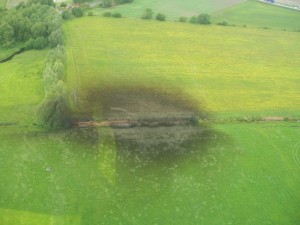A longitudinal rupture occurred at approximately 6 a.m. on a crude oil pipeline (DN 500, buried depth: 1 m in clayey soil; commissioning date: 1965; pressure: 69 bar) at 1.5 km from a nature reserve. No disturbance or pressure surges in the pumping operation were observed before the accident. The pipeline was shut down and isolated when alarms sounded in the control room. Soil and trees over 6.4 ha were polluted by hydrocarbons.
After locating the leak, the operator initiated its safety and intervention plan (SPI) at around 8 a.m. A safety perimeter of 300 m was established. The leaking section was isolated. The transporter issued a press release at 9:50 a.m.
Dams were deployed to prevent any contamination of the Seine River or the Tancarville canal. Pumping of the crude oil-water mixture (groundwater table at 20 cm) began at approximately 3 p.m.
More than 450 truck trips were needed to recover 4500 m³ of water mixed with hydrocarbons. Treatment was performed via suitable temporary facilities nearby. Surface water and groundwater samples were taken to monitor the water quality.
A few dead wild animals (coypus, ducks, moorhens, etc.) were found. An animal barrier and net were installed around the excavation. The administration also took measures to prohibit the mowing of polluted grasses. The cost of the environmental cleanup, decontamination and rehabilitation operations was evaluated at more than €1 million.
The rupture in the structure was characterised by a crack measuring 87 cm long by 9 cm wide along the upper generatrix, on either side of a circumferential butt weld, but away from the longitudinal welds. Expert metallurgical assessments were conducted to characterise the mode of degradation.
The pipeline underwent three complete inspections between November and December 2013, the final results of which have only been known for a few weeks (pigging to detect thickness losses, geometrical defects and cracks in the pipes).
The expert metallurgical assessments at the rupture showed regular cavities over 3 m along the upper generatrix, signs of external aggression which may have damaged the pipeline during older work conducted with construction equipment. A section measuring several metres long was replaced to eliminate the defect.
Excavations were performed on the remainder of the pipeline to check for similar defects and to inspect/repair the most critical defects identified by recent pigging operations.
The repaired pipeline was returned to service at reduced pressure on 27/06, pending the complete verification of all the defects noted during the recent pigging operations.
Based on the reading of the data of the crack detection pig, it was very difficult to suspect the existence of cracks in the rupture. However, suspicious indications appeared in the same place on the results of the thickness measurement pig. It is therefore essential that the interpretation of data form one inspection can be correlated with the data from other inspections. A debate on the methodology for analysing the results (recalibration of the models used) was initiated.
Download the detailed report in .pdf format (2.5 Mb)




